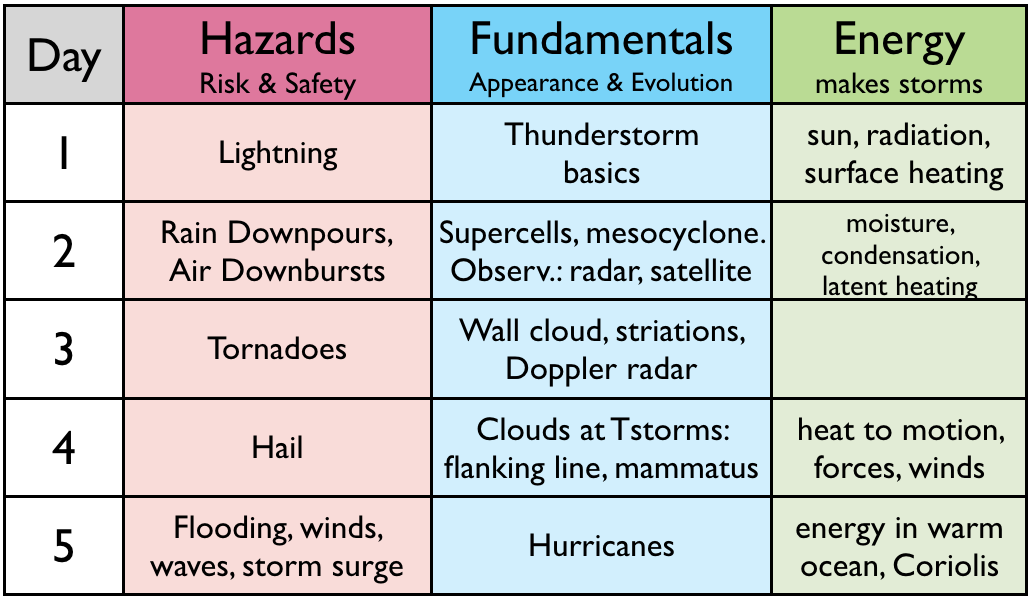The "roadmap" table below outlines what we cover each day.

Learning Goals (LG) are listed at the end of this web page.

"Pursuit", a video by Mike Oblinski, is a wonderful "teaser" that you can watch before class starts. It shows beautiful time-lapse images of thunderstorms and many of their hazards. https://www.youtube.com/watch?v=oagszCmJLpU (7:36. Not testable. Can be viewed at 1.5x or 2x speed.)
| Hazards |
Welcome, and introduction to storms by Prof. Roland Stull. (1:30. Lecture Video snippet d1s01.)
YouTube video on "How Lightning Works" by Pecos Hank. https://www.youtube.com/watch?v=JXhif3E3l2s (Watch all, except skip the section between video timing marks 6:50 and 8:05. That leaves 9:45 of video.)
Not testable. Additional interesting YouTube videos on lightning.
|
Lightning types, intensity & frequency. (2:13. Lecture video snippet d1s02.)
Videos (testable) of what happens when lightning strikes a car, the ground, or a tree near you.
YouTube video about what happens to you if you are in a metal car that is struck by lightning? BBC Top Gear. https://www.youtube.com/watch?v=GZxgYNnkBd0 (Watch only the portion between times 2:40 and 5:00.)
YouTube video on ways that lightning can hurt you via a tree or the ground. Univ. of Manchester. https://www.youtube.com/watch?v=7QS9Halhqgg (start at 0:45, and end at 3:45.)
Wood schrapnel -- another hazard when lightning strikes a tree near you. A gif video from C. Chan. (0:15).
Where are the greatest risks of lightning? (1:58. Lecture video snippet d1s03.)
Lightning detection methods:
Ground based networks (3:04. Lecture video snippet d1s04)
Satellite Geostationary Lightning Mapper (YouTube video from NASA & NOAA. https://www.youtube.com/watch?v=UXlLzFqcGMU 0:44, but play at 2x speed)
Roland Stull's mis-adventures with
weather. Vignette 1: Hiking on a ridge-top trail as a
thunderstorm approaches. (1:37. Lecture video snipped d1s06.)
(Not
testable.) Which leisure and work activity, and which gender, is
associated with the most lightning deaths? (See info below.)
Not testable.
|
| Fundamentals |
What do thunderstorms look like? What are their key
features? What are thunderstorm cells and how do they evolve?
(4:21. Lecture video snippet d1s07.)
YouTube video of a single cell (the brightest
cloud in this time-lapse video) evolving from the cumulus stage (no
anvil) to the mature stage
(with an anvil spreading out at the top, and rain coming out of the
bottom). As this thunderstorm evolves further, an additional cell
starts to form in the foreground of the video (cumulus stage) while the
older cell is in the mature stage. Namely, the thunderstorm has
become a multi-cell storm. https://www.youtube.com/watch?v=h6jh4Zp0u08 (0:56)
Not testable. An additional YouTube video explaining the life cycle thunderstorm cells.
|
| Energy |
Solar heating creates different layers in the atmosphere. (2:37. Lecture video snippet d1s08.)
The energy balance at the earth's surface, and how it varies with time of day. (4:12. Lecture video snippet d1s09.)
Favorable thunderstorm regions around the world. (1:32. Lecture video snippet d1s10.)
The Learning Goals below are a good study aid
for the topics we covered today. Review
them now to reinforce your understanding.
Also, if you didn't get a chance to view the wonderful "Transient"
videos (see the links just before the Fundamentals section), I highly
recommend viewing them. They are inspiring.
See you next time. Cheers, Prof. Roland Stull.
By the end of this lesson, you should be able to:
1a) describe different types of lightning, and explain the sequence of events in a lighting strike
1b) explain lightning risk: dangerous times and places; how it affects people; and what you can do to stay safe.
1c) identify and describe typical components of a thunderstorm cloud, and describe the nature and evolution of cells in different types of thunderstorms
1d) identify atmospheric layers and explain how they relate to storms
1e) explain how solar energy can get into the atmosphere to power storms